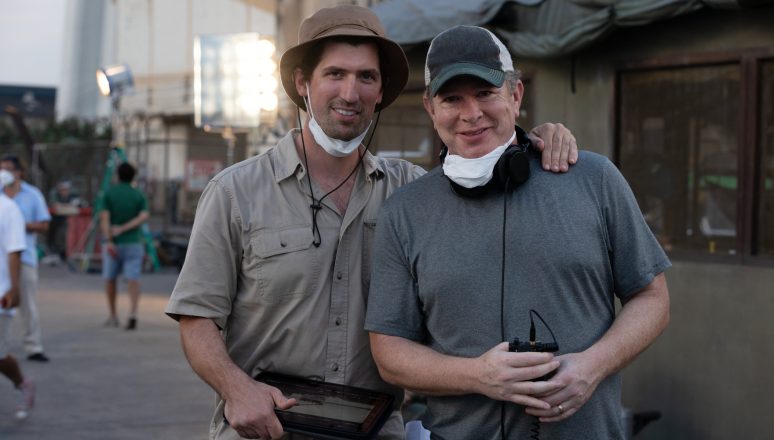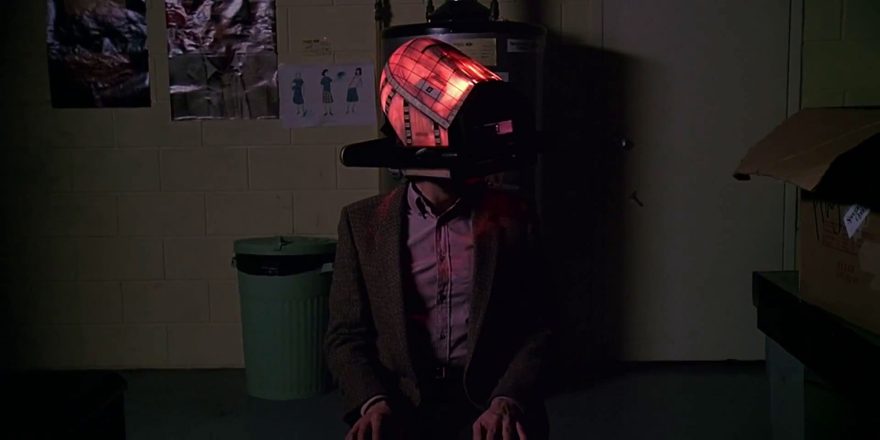Step 1: Start With a Script That Doesn’t Work
There’s a terrifically unimaginative old saying in producing circles that goes, You’ll never make a good film out of a flawed script.
To be sure, a good script or even a great one can be misinterpreted, misshaped or mishandled any number of ways into a mediocre or straight-up bad film. But a flawed script, warns the adage, will never turn into a great night at the movies.
By the time Greg Jardin’s screenplay for It’s What’s Inside landed at my production company, Such, it had already spent several years getting passed on by numerous other producers. The dialogue popped and felt original, and the central sci-fi concept of eight old friends reuniting at a party and using a hi-tech device to swap bodies crackled with possibilities. But on the page, Greg’s dazzling vision was so ambitious – everybody’s everyone all the time! – that it tended to baffle most producers. Some thought the script seemed fun, but dismissed it as too convoluted. Others said that there was just no way anyone could pull it off. Too confusing for an audience to follow along.
Interesting, but … flawed.
Years ago, I worked for a stretch as a screenwriter with middling results. The self-indulgent story of how screenwriting drove me crazy and made a therapist laugh me out of his office after our first and only session together is a tale for another time. A welcome long-term side effect, though, is that whenever I read a truly inspired screenplay, I now fall into a kind of astonished awe like a minor fugue state. I am fairly confident that I’m not the only one this happens to. (Right? Please??)
“How could an actual flesh-and-blood human being make this?” my delighted vestigial writer’s brain wonders.
That’s what happened to me after my first dizzying read of It’s What’s Inside, even though I can’t say that I was able to grasp the whole of Greg’s script. What I could tell was that he envisioned something exciting and specific and powerful. And I wanted to see what he saw.
So, I admitted to Greg that I couldn’t quite see all of it myself, but – brace yourself, reader – I asked him to explain it. How would the body swaps work onscreen? How would the audience keep track? How could we know who was in whose body?
He told me how everything would work, in great detail and with even greater enthusiasm. The in-camera effect of the body swaps … the red-light X-ray effect … the dynamics of actors throwing themselves headlong into multiple roles. His description blew my mind and captured my imagination, but of course, it still couldn’t be divined from his directions on the page. I asked him if he could feather what he’d told me into the key points of the script before we sent it out to actors’ reps and department heads. And so he did. All systems go.
Except…

Step 2: Hire a Director With Zero Film Experience
Greg had never directed a feature before. That was widely viewed as red flag standing in the way of a green light.
Since the director holds most of the film’s fate in his hands, production companies scrutinize the financials of his recent films to measure budgets against either box office earnings or sales to distributors, or both. An additional step is to reach out to actors, department heads and producers from the director’s last film or two to see how it went. What was the atmosphere like on set? Were the actors relaxed and able to do their best work? Did the workday often drift into overtime? When there are no recent film, it makes it kind of hard to inquire.
However, Greg had amassed a body of work from standout commercials and music videos which he had not only directed but which he had also edited and handled visual effects on. Some of his projects had gone on to win awards, but all of them struck my company and me as works of a true artist with a lethal set of skills.
We assessed his past works along with his considerable capabilities, passion, style and infectious humor. We then talked through the script amongst ourselves to synthesize how all those elements could come together under his direction. What we came away with was the sense of a film that felt electric and exciting and genuinely unique, one we thought audiences would love and we couldn’t wait to see ourselves.
Step 3: Don’t Just Go Over Budget – Go Over Schedule, Too
One side of the independent film coin is that it’s a business start-up. As with any start-up, you overshoot your budget and schedule at your own peril.
The film’s investors are trusting you, the producer, to treat their investment – the production financing – with the utmost care and respect. Once the budget is approved, any additional financing can dilute the value of their financial contributions and thus shrink their shares of any potential payout. Beyond this, though, going over budget by any serious measure is usually an indication that something has gone wrong. The last thing anyone wants is to get caught in the trap of throwing good money after bad.
As far as your schedule goes, the clock starts ticking on day one of principal photography and doesn’t stop until you’ve completed post-production or, more accurately, sold the film to a distributor. The sooner everything is in the can and ready to go out into the world, the sooner your investors can hope to recoup their investment.
So, how did It’s What’s Inside’s balance ledger and calendar turn out? Well, the final production costs roughly doubled the original estimates. And the post-production schedule went about six months past what was initially planned.
Nailed it.
Why did these historically risky shifts work – and why was Such OK with approving them and bearing additional financial risk in the first place?
Knowing that we might soon find ourselves in multiple active productions with varying needs, Such had raised a dedicated film production fund from a small group of trusted investors before we ever saw the script for It’s What’s Inside. This approach meant that we could move quickly and decisively, sort of like a small-scale studio, rather than having to first obtain approval from multiple third-party entities whose interests and viewpoints might not be aligned.
Also – and I think this was the key – as a boots-on-the-ground producer, I had been working with Greg from before preproduction into the actual shoot and up through the edit. This organically lead to an easy flow of communications and a real-time account of operations from Greg and myself to my business partners and our investors, thus diminishing the usual gap between the filmmaking and the financing side of things. We could see for ourselves and in a very real way that Greg was making a special film. When he requested more time and resources for reshoots, additional art and production design, test screenings, and so on, we knew that these were anything but Band-Aids. They were upgrades that were simply what the film as a work of art, and Greg as its artist, required for it to become all that it could be.
This is not to imply for one second that more time and money inevitably result in a better film. Oftentimes, constraints on a production are not only necessary or unavoidable, but they also lead to inspired and creative results. Still, I have worked on productions where the producers holding the reins stick to the original budget and schedule at all costs, come hell or high water.
That ignores the flipside of the coin, where independent film is, of course, an art form. As with any work of art, a film can’t always be told what its scope and schedule must be, if all of its potential, flavor and colors are to be revealed.

Coda
It’s What’s Inside premiered at the 2024 Sundance Film Festival to a packed house whose laughter and cheers still feel like the stuff of dreams. Three days later, following a studio bidding war, we sold the film to Netflix for $17 million. Given all publicly available data, this meant that, pound for pound, budget to distribution deal, our movie had broken the record for the sale of an independent film.
Now, here again are the three steps, this time without the wink and whether you’re a film producer or not: Play your game. Find your people. And make your work, even – no, especially – if it means breaking a few rules.







